Elementary Rules of the Detective Story
In 1887, Arthur Conan Doyle unwittingly changed world literature. At the time, he was a struggling doctor, trying to build a practice and make a little money on the side. When his novel, A Study in Scarlet, was published, he launched the modern detective genre and set the standard that mystery stories follow to this day.
Conan Doyle of course had a long, rich career as a mystery writer. He even wrote several stories that debuted in The Saturday Evening Post, including “The End of Devil Hawker,” published in 1930.
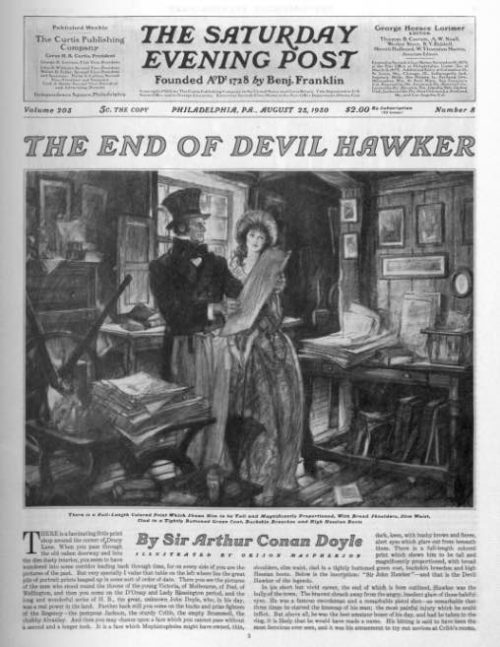
For those who wish to follow in Conan Doyle’s footsteps, in 1920, Ronald Knox wrote these rules for a group of mystery writers to help them avoid plot tricks and clichés.
- 1. The criminal must be someone mentioned in the early part of the story, but must not be anyone whose thoughts the reader has been allowed to follow.
- 2. All supernatural or preternatural agencies are ruled out as a matter of course.
- 3. Not more than one secret room or passage is allowable.
- 4. No hitherto undiscovered poisons may be used, nor any appliance which will need a long scientific explanation at the end.
- 5. No Chinaman must figure in the story.
- 6. No accident must ever help the detective, nor must he ever have an unaccountable intuition which proves to be right.
- 7. The detective must not himself commit the crime.
- 8. The detective must not light on any clues which are not instantly produced for the inspection of the reader.
- 9. The stupid friend of the detective, the Watson, must not conceal any thoughts which pass through his mind; his intelligence must be slightly, but very slightly, below that of the average reader.
- 10. Twin brothers, and doubles generally, must not appear unless we have been duly prepared for them.
In 1931, another British mystery writer added a few more rules of “respectable” mystery writing. In “Crime Fiction According to Hoyle,” Valentine Williams — another mystery writer — emphasizes that readers want a well-paced plot that is plausible, suspenseful, and finishes with a surprise.
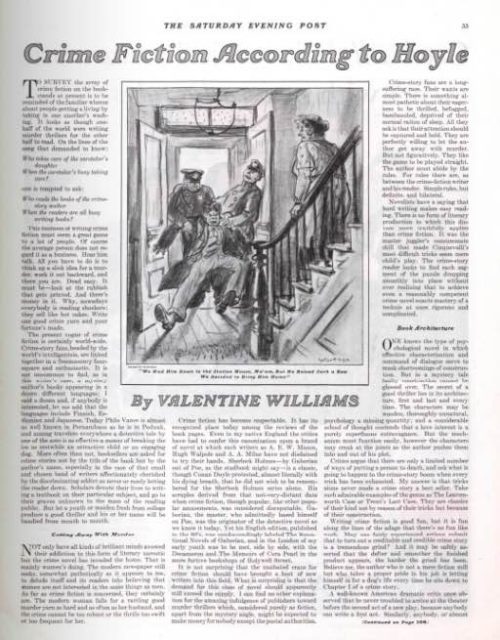
The Best Movies to Watch This Fall
Noted film critic Bill Newcott, creator of AARP’s “Movies for Grownups,” offers his picks for the coming season.
Murder on the Orient Express (Nov. 10)
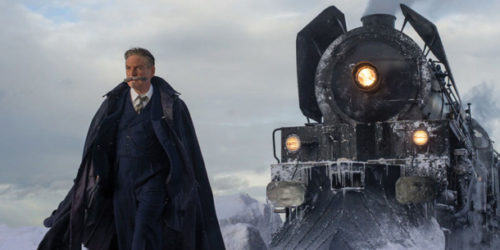
Kenneth Branagh (who also directs) stars as Hercule Poirot in the second big-screen version of Agatha Christie’s classic. When a train passenger (Johnny Depp) is killed in his compartment, Poirot gets to work probing an all-star cast of suspects, including Michelle Pfeiffer, Willem Dafoe, Penelope Cruz, and Judi Dench.
Darkest Hour (Nov. 22)
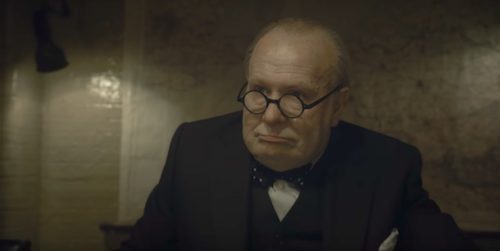
For those who complained that Christopher Nolan’s summer blockbuster Dunkirk failed to give sufficient context for Britain’s defining event at the outset of World War II, here comes Darkest Hour, the compellingly human story of how Winston Churchill summoned his country’s resolve when all seemed lost.
Gary Oldman gives the performance of the year — and perhaps of his life — as Churchill, thrust into the position of prime minster at the very moment Hitler is absorbing all of Europe under the Nazi banner. Alcoholic, physically frail, and haunted by his disastrous military experience in World War I, he’s a guy who dreamed of being prime minister his whole life … only not under such dire circumstances.
No sooner has Churchill moved into 10 Downing Street than virtually the entire British army finds itself stranded on a beach in Dunkirk, just across the English Channel but out of reach of transport ships, which are being relentlessly bombed by German planes. Besides facing external threats, Churchill is almost immediately undermined by outgoing prime minister Neville Chamberlain (Marigold Hotel co-star Ronald Pickup) and the weaselly Lord Halifax (Game of Throne’s Stephen Dillane), who has designs of his own on the prime minister’s office. These two desperately want to negotiate with Hitler and are more than willing to hand over Europe if he’ll just keep his mitts off Dear Old Blighty.
Oldman’s Churchill, battling depression and personal demons, barely has the strength to summon his own courage, much less instill it in his countrymen. But in a truly enchanting — and, I’d guess, wholly fanciful — scene, he finds himself riding a crowded London underground train where, to his utter astonishment, he finds the brave words of ordinary folks inspiring him to do the right thing.
The greatness of immortal leaders, Darkest Hour tells us, is generated not from within themselves, but from the wisdom and vision of those they lead. A powerful lesson for Winnie, and one worth remembering 77 years later.
The Current War (Nov. 24)
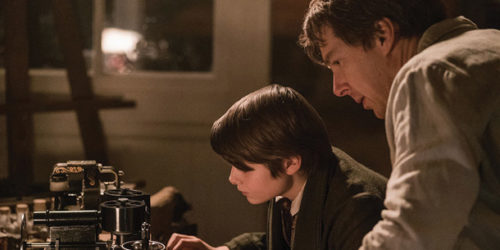
How’s this for a crackerjack movie idea: Thomas Edison goes to war with George Westinghouse over how best to deliver electricity to the masses: AC or DC.
What, you’re not at this moment frantically dialing Fandango to reserve your tickets? Well, it’s surprising how much mileage writer Michael Mitnick (TV’s Vinyl) and director Alfonso Gomez-Rejon (Me and Earl and the Dying Girl) get from the premise — and how compelling Benedict Cumberbatch (Edison) and Michael Shannon (Westinghouse) are in their roles.
Every schoolkid knows (or should know) the story of how Edison experimented with thousands of possible filaments for his light bulb before hitting on the one that could burn for hundreds of hours. But getting light bulbs into America’s homes was one thing; pushing the necessary electricity through wires into every U.S. neighborhood was quite another. Edison’s preferred direct current system required transformers every couple of miles, but was so safe you could press your hand to a bare wire and not get shocked; Westinghouse’s alternating current could travel hundreds of miles but, if handled without insulation, would cause instantaneous death.
And so the drama unfolds, the two men feuding from afar, sniping at each other in the press, secretly envying each other’s unique elements of genius. Cumberbatch’s Edison has the boyish charm that endeared the inventor to America, masking an all-consuming ambition. As a Westinghouse, Shannon presents a guy who is more businessman than visionary, a gentleman appalled by his rival’s dirty play (Edison convinces the State of New York to execute a prisoner via AC current and then goes about declaring that the man had been “Westinghoused”).
If you’re wondering who won the AC-DC debate, be my guest and stick a finger in the nearest wall socket. For a gentler and more appealing charge, experience the enlightening history of The Current War.
The Shape of Water (Dec. 8)
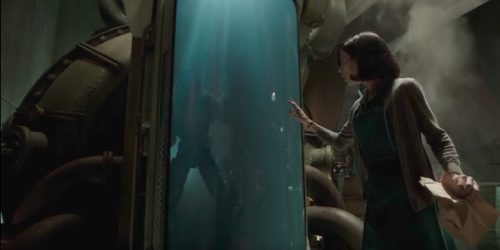
Imagine E.T., only instead of outer space, the alien is from beneath the sea, and instead of a little boy named Elliot, the hero is a mute middle-age cleaning woman named Elisa, and instead of hiding in a closet, the alien stays in Elisa’s full bathtub.
As in E.T., the alien is the subject of a U.S. government search that is likely to end in his death and dissection. Unlike E.T., there’s quite a bit of nudity and just a smidge of alien-human sex.
Those are the ingredients of Guillermo del Toro’s The Shape of Water, at once a nearly beat-for-beat remake of Steven Spielberg’s 1982 classic and also a uniquely grown-up fable of forbidden love, high adventure, and magical images. From the opening shot — Elisa’s dream of living underwater, her apartment furniture bobbing about as if the place were a submerged Titanic stateroom — del Toro immerses us in his unique brand of Fantasyland… forbidding and irresistible, dangerous and delightful.
Sally Hawkins (Maudie), ratcheting up her Adorable Quotient to DEFCON 1, stars as Elisa, a meek and mute laborer who operates a bucket and mop at a top-secret government research laboratory along with her adoring partner Zelda (Octavia Spencer). Behind one heavily fortified sliding door, they encounter a most unusual research subject: a Creature from the Black Lagoon-type character with whom Elisa strikes up a tentative after-hours friendship.
It’s not much of a relationship at first, just some informal sharing of hard-boiled eggs. But soon they’re conversing in sign language and listening to Benny Goodman records together, and when Elisa learns that a cruel-hearted military scientist (Michael Shannon) is planning to cut the critter open to see what makes him tick, she engineers a brave and daring escape plan.
Once Beauty and the Beast are alone in that apartment, well, that’s when the similarities to E.T. take a momentary leave of absence.
Shannon, whose performances here and in The Current War embody his startling versatility, plays the heavy with Big Bad Wolf ferocity, his performance tempered by some revealing glimpses of his unhappy home life. Richard Jenkins, always a welcome sight, turns up as Elisa’s artist neighbor, a struggling illustrator whose own tentative search for affection inevitably ends in cold rejection. The two men’s hollow lives add to the poignancy of the film, infusing it with a sense of yearning, a melancholy Elisa just might be able to break through with her most unusual love.
Visionary as always, del Toro (Pan’s Labyrinth, Hellboy) brings his uniquely Mexican celebration of the fantastic and grotesque to bear in The Shape of Water. Next up: His take on that darkest of fairy tales, Pinocchio. I can’t wait.
Star Wars: The Last Jedi (Dec. 15)

When we glimpsed Luke Skywalker at the end of 2015’s The Force Awakens — 32 years after his previous appearance in Return of the Jedi — he was just sort of standing around atop a cliff. We’re guessing Luke (Mark Hamill) will have a lot more to do in this follow-up, including, we hope, a reunion with his sister, Princess Leia (played by the late Carrie Fisher in her final role).
This article is featured in the November/December 2017 issue of The Saturday Evening Post. Subscribe to the magazine for more art, inspiring stories, fiction, humor, and features from our archives.
Follow Bill Newcott at saturdayeveningpost.com/movies or at his website, moviesfortherestofus.com.
9 Least Popular Halloween Costumes
Whether trick-or-treating, attending a boozy party, or escaping psychopathic murderers in the woods, everyone loves dressing in costume for Halloween. Here are the costumes that no one is wearing.
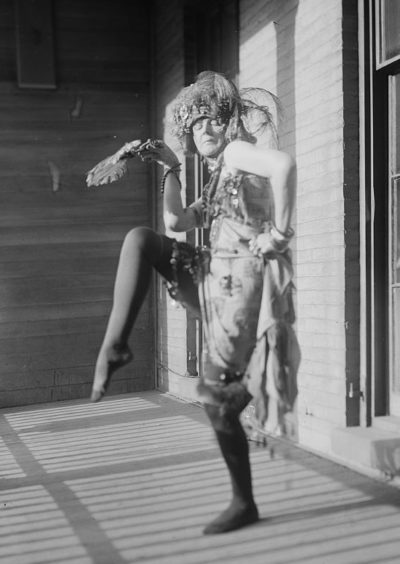
1. Elsa
That’s right, Elsa von Freytag-Loringhoven, the turn-of-the-century German-American Dadaist writer and artist! Trick-or-treaters haven’t yet caught on to the possibility of portraying the woman who may have been responsible for Marcel Duchamp’s “Fountain” sculpture. Perhaps she is still ahead of her time.
2. Baby Tax Attorney
Isn’t she cute? And a real wiz on the capital gains tax. Animals are a clear favorite costume choice for babies, but there is a lot of uncharted costume territory in the government and financial sectors.
3. Blockbuster Employee
Brick-and-mortar locations for movie rentals might as well be an enchanted fairyland these days. The teenage movie critic/cashier was an antiquated role in the media industry that could evoke incredulous stares from Generation Z members dressed as fidget spinners.
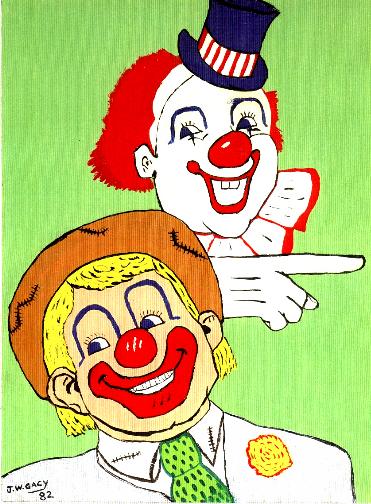
4. A Wholesome Clown
No sharp teeth, no maniacal grin; just a goofy jester who makes people laugh and doesn’t eat them. Is that so much to ask for?
5. The Creature from the Blue Lagoon
What could be creepier than Randal Kleiser’s 1980 film about marooned romance between two coming-of-age cousins?
6. Baby Chayote Squash
These firm Latin American fruits are excellent in stir fry, but maybe less desirable as an infant costume. The fist-sized, green squash is admittedly less iconic than a jack-o’-lantern, but it’s an easier costume than Baby Baby Kale.
7. Dog Lady Gaga
Dressing up your pooch as the eccentric pop sensation herself is an understandable goal, but nearly impossible. Gaga’s signature headpieces and delicate lace are too intricate for canine wear, and we all know how the meat dress goes over.
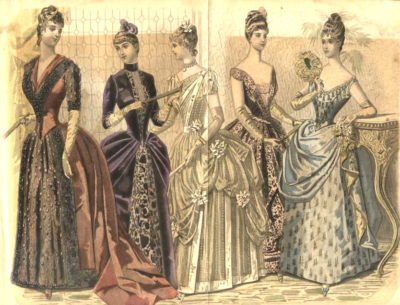
8. ’80s Costume
Who could forget the iconic fashion of the 1880s? Most people, apparently. The bustles and morning coats of the Gilded Age are rumored to be making a comeback. As if!
9. Sexy Blobfish
The “World’s Ugliest Animal,” according to CNN, is a deep-sea sac of loose skin with a bulbous nose called a blobfish. It’s a cross between Squidward and a failed jello mold. It would take a Halloween miracle to make this formless fish attractive.
Joan Crawford and the Job of Keeping at the Top
Originally published June 17, 1933
Actress Joan Crawford knew the workings of Hollywood inside and out – and she put that knowledge to good use throughout her career. In this first person account, she explained what it took to get to the top in Hollywood.
There are plenty of hazards in getting to the top, or in staying there. In fact, the higher you rise, the more is expected of you. Mistakes are less readily overlooked or forgiven, even though your work depends largely upon the cooperation of others, such as studio executives, directors, editors, writers and the rest.
That being the case, what do I see as I look back, survey my present foothold on the film peaks and peer ahead? My chief feeling about it is one of astonishment, tinged with unbelief, in spite of the driving ambition to make good; and speaking of ambition, I honestly believe that there is no limit to success. I do not believe that any artistic person, any truly creative person, is limited any more than true ambition is limited. I was once asked, “Now that you have realized your ambitions, Miss Crawford, what next?” I answered, “A new ambition.” For when one goal is realized, a new one is ahead.
As I look back over my own career, I see a succession of these changing goals.
The danger of being “typed” by the producers, which, in turn, fixes you irrevocably in the public eye, is one of the haunting fears that an actor must meet and conquer — if it is to be conquered — with cool judgment and common sense. As you may recall, my initial success was in the role of a dancing girl, ultramodern, seeking a good time and having it. I am grateful to that character, for she brought me good luck and success; but I began to feel that if I were pigeonholed too carefully, I would soon be forgotten.
Was I able to do something besides that dancing girl with whom I had become identified on the screen? I thought I was. ere was pent up inside me a great urge to do dramatic roles. I sought advice but believed my own heart, and I finally begged to be allowed to try a real emotional role. It was, perhaps, the most critical moment in my career. If I failed in my attempt, I had nothing to blame but my own impetuousness, and I would lose what audiences I had as that modern girl.
Shivering inwardly — I always do that; I die a thousand deaths a day from timidity and indecision — I began to make Paid. I remember that every time when I stepped away from the camera after having done a big scene, I searched the faces of the cameramen and electricians, hoping for their approval. Once, I remember, I finished a very dificult scene. No one said whether I did well or not. They all started busying themselves with preparations for the next shot. I stood there a moment in despair, and then something impelled me to look up. High above me was the electrician who handles the overhead lights. He nodded to me and, with his lips, formed the words, “Good girl, Joan.” And I knew I had done well.
From that time on, my style in acting underwent revolutionary changes through a step, a leap — sometimes a bad fall taught most — in such plays as Possessed, Grand Hotel and Letty Lynton. It was a thrilling progression, exhausting every resource I had and drawing upon new ones that I had never had the opportunity to use. As I look back now in critical examination, I can hardly believe that the girl who did the Taxi Dancer was the same person who played Letty Lynton. Of course I was young and malleable, for it seems to me that I have been recreated, in a sense, both physically and mentally.
Kaleidoscopic as Hollywood must be in most things; it is rigidly fixed in a few that are vitally important for a star to know and act upon correctly. As an example, a screen star must be a voluntary prisoner in Hollywood in the pursuit and maintenance of her success. She dare not leave her confines for more than a few weeks at a time, unless she wishes to run the risk of returning to find herself forgotten. Time and again I have seen stars try to come back, only to be met with failure. Actually, I have had one real honest-to-goodness vacation in four years.
Another fixed Hollywood principle is that a star cannot afford to be more than half right in a studio quarrel. And half right can be too much! Differences must be arbitrated if the star, right or wrong, wishes to survive. If you win a battle against your studio against its will, where are you if the studio decides to keep you off the screen?
I am emphasizing this side of the human problem that affects all of us, more or less, in every activity, because it is peculiarly poignant in Hollywood, where to make a bad picture is a mistake of the first magnitude, and where, though it may be the result of other hands than your own and factors beyond your control, a star must be prepared and willing to accept the brunt of the fiasco. Mistakes are heartbreaking to a star, because the margin of safety is so slight.
Outside of actual working hours before the cameras, I find it expedient and necessary to give most of my waking time to keeping up with the job. These details are threefold. Let me give you an idea of the various side issues and obligations that must be met if an actress is to keep her place.
Though many actresses — I among them — do not pick their own stories for filming, we should never let up in the search for suitable ones. So novels must occupy a considerable percentage of leisure time. We know the importance of a good vehicle, and whenever I come upon what I think a possibility, I bring it to the attention of the studio. Even if it isn’t right for me, it may prove just right for someone else, although I may not like to relinquish my find.
Because it is necessary for a woman star to be abreast, if not a jump ahead, of the constantly changing modes, it is part of the many-sided job to scan all the fashion magazines, and if I come across the picture of a model that I like, no matter how advanced at the moment, to send for it on approval. A friend in New York helps me to get quick action on the fashion front. This, of course, is for my personal wardrobe. My picture clothes are in the capable and artistic hands of a marvelous designer.
Then there is the everlasting hair arrangement to consider and experiment with. I watch for new coiffures and try them out. I know how important a woman’s hair is, and I think an actress should have the coiffure take on fresh lines and values in each character she plays. The smallest physical adjuncts created for a role lend to it a zest that your audience is quick to appreciate. Men may not know the why — for of the new appeal, but the women do every time.
Further Considerations
Physical exercise, correct diet, sufficient sleep are all to be taken into account, and they are more often than not difficult to achieve when you are on the set from 8 o’clock in the morning until 6 at night and have to put in the hours after 6 in studying a scene for the next day and in having your hair done. And if you have days between pictures—which means that you are theoretically free to relax or do what you please—in all likelihood you have settings for gowns to be worn in the next picture, interviews with newspaper and magazine people, dancing lessons for a picture in the offing, and a ton of overdue correspondence to read and answer.
The fans are a dynamic influence — and a highly valued one. The public makes or breaks. And in a star’s life there are two publics to please — the public that goes to see her on the screen and the public that insists on physical contact when she is off the screen and one of the crowd. These two publics are interchangeable to some degree, but the approach to them is entirely different. And they are equally important. Living in the public eye is part of your stardom, and if you really want a private life, you should not have tried to be a star.
Yet I also know that nothing in the world could compensate me for losing my place in them. The stress and strain are terrific, but the fascination and joy of work in films have no parallel comparison in my life.
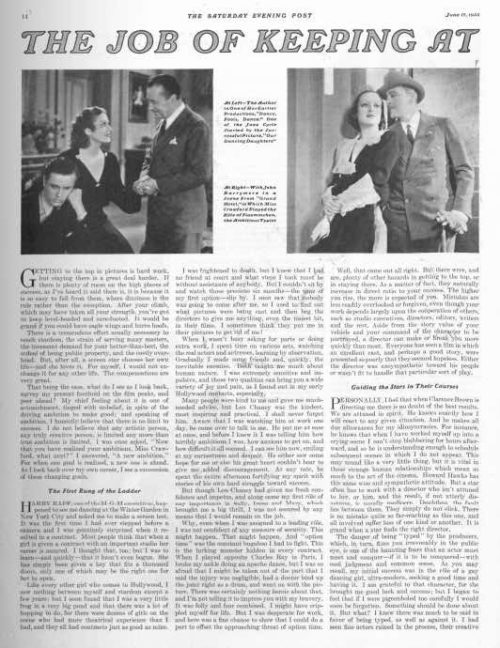
This article and other features about the stars of Tinseltown can be found in the Post’s Special Collector’s Edition, The Golden Age of Hollywood. This edition can be ordered here.
Are Grand Juries Fair?
Grand juries are playing a large role in special counsel Robert Mueller’s investigations into Russian meddling in the 2016 presidential elections, recently handing down sealed indictments against former Trump campaign chairman Paul Manafort and his associate Rick Gates.
The United States is one of only a handful of nations to still use grand juries. Nearly every other nation that once used them has abandoned the practice. They have shifted the functions of a grand jury — which decides whether or not to prosecute a case — to other offices in their legal systems.
But grand juries are still important in America. The Fifth Amendment requires federal courts to use grand juries before prosecuting “capital, or otherwise infamous crime.”
In 1974 and 1975, following the grand jury investigation into Watergate, the role of grand juries was debated in The Saturday Evening Post.
In “The Grand Jury vs. You,” historian David Rothman argued that the indictment process should be in the hands of judges, and not grand juries. Rothman objected to grand juries’ secrecy, as well as the jury members’ ignorance of the law as it pertained to the cases they were being asked to judge.
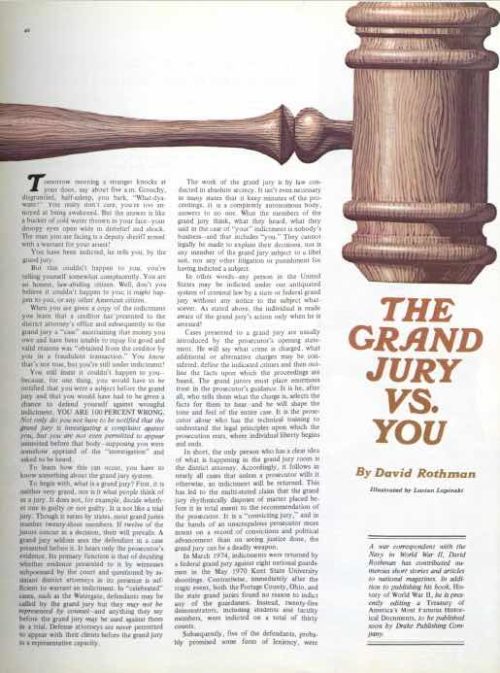
Six months after Rothman’s article appeared, Lloyd E. Moore defended the system in his article, “The Grand Jury Is You.” Moore pointed out several unique benefits of the grand jury system. For instance, if a grand jury votes not to proceed with prosecution, the subject of the inquiry might never even know he or she was being investigated. Just as important, the suspect’s family, neighbors, and employers wouldn’t know either. Another benefit he noted is the grand jury’s ability to follow their inquiries to their conclusion, despite obstruction from government officials as high up as the president.
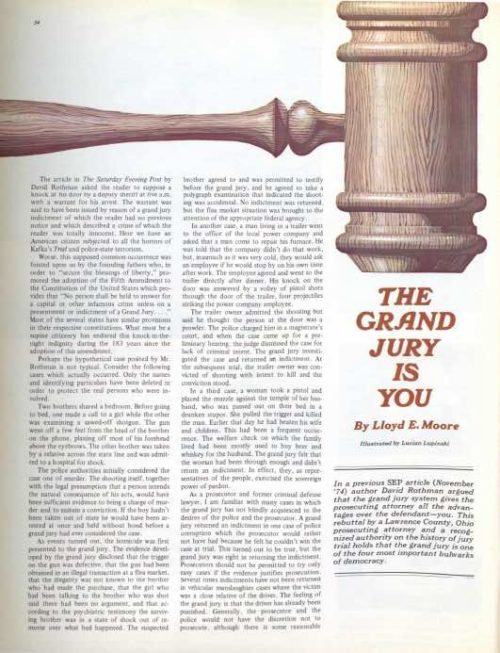
July/August 2017 Limerick Laughs Winners and Runners-Up
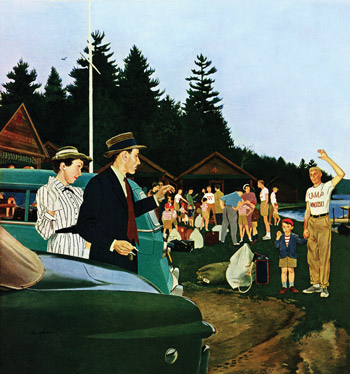
Have a good time at camp, and goodbye.
We will pick you up come mid-July.
While you fight off mosquitos,
We’ll sip on mojitos
And blast the ol’ A/C on high.
Congratulations to Jennifer Klein of Tel Aviv, Israel! For her limerick, Jennifer wins $25 and our gratitude for her witty and entertaining poem describing First Day at Camp, George Hughes’ cover from July 3, 1954.
If you’d like to enter the Limerick Laughs Contest for our next issue of The Saturday Evening Post, submit your limerick through our online entry form.
We received a lot of great limericks. Here are some of the other ones that made us smile, in no particular order:
As much as I want to enjoy it,
An issue exists that might spoil it.
Not the missing TV
Or my teddy, you see,
But the lack of a working flush toilet.—Paul Desjardins, West Kelowna, British Columbia, Canada
To his parents it’s perfectly clear:
Their boy does not want to be here.
All morning he’d fussed,
But he soon will adjust,
And be begging to come back next year.—Joyce Petrichek, Finleyville, Pennsylvania
We’ll see you the first of September.
You’re mad at us now, but remember:
If Mom gets her way,
By April or May
We’ll have a new family member.—Roger Harris, New York City, New York
The mother, she looks apprehensive.
The boy looks a little bit pensive.
And as for the dad,
I suppose that he’s mad
That this summer camp’s so darn expensive.—Neal Levin, Bloomfield Hills, Michigan
Daddy says camping is cool —
No homework, no lessons, no school.
Now I will have fun
But they will have none,
Just drinking their wine by the pool.—Bonnie Draje, Solon Springs, Wisconsin
Just think of the fun you’ll discover
At camp, while I’m home with your mother.
And if all goes to plan
We will increase our clan,
And you will come home a big brother!—Michelle Gordon, Airway Heights, Washington
Our look says, “We love you, dear one.”
We know that this camp will be fun.
Yet, while you’re away,
We grown-ups will play,
And we’ll miss you — a little — dear son.—Joan O’Kelley, Hoschton, Georgia
A boy tries his best not to cry
As his mom and his dad wave goodbye.
I don’t mean to annoy,
But which one’s their boy?
The artist does not specify.—Sam Beeson, American Fork, Utah
This seemingly heartbroken scamp
Is secretly eager for camp.
It gives him a while
To practice a style
His parents would otherwise cramp.—Jeff Foster, San Francisco, California
Branches
We climb the old maple tree and sit, legs swinging, as our parents push cautious hands together and file inside, their faces flushed with the guilt of secretly saying things they know we already know. She climbs a branch higher than me and perches there, like a white-faced bird about to fly away. I sit low. Closer to the ground. Solid and heavy and breathless with fear.
It’s August. I can feel the spiders of sweat down my back, her blue bangs stick like warm plastic to her forehead. She wipes her hand across her eyes. Eyeshadow smears, a gory effect on her pale skin.
The universe is not for us this summer. I am back in the thick black clothes I said I threw away, safety pins in my ears, a hood over my head, hiding behind the dark and the strange. She’s started drawing on her hands for the first time since her grandma died, swoops of ink curving off her nails, striping her fingers, dangling loose-ended over her wrists. Looking at us, an uninformed stranger would shake his head. Mutter rude remarks. Might even go so far as to call us ungrateful teenagers, emo for no reason. No one could tell that the skinny girl with fake tattoos is dying from the inside out.
She talks too fast, telling me what has happened since we were last together. We don’t see each other much anymore. I have always known that happens, that the people you are friends with as a kid will move and marry and make families so big there is no room for you left in their hearts. I never thought of dying, but I’m sure that is included.
Looking at her and the smeary eyeshadow war paint, the staticy strands of hair, the way you can see her heartbeat in her neck, I feel a sudden ache, like a gap in my chest is filling too fast with water. I can’t lose her.
I don’t have a choice.
Last year, when she told me everything, I climbed to the top of the maple and tried to make myself fall. Tried to pretend that my death was unavoidable, that I had to live every moment knowing it was soon to come. It was no use. I am a coward. My hands knotted around the tree. My feet were stubborn. Climbing down, I knew for a certainty that I am selfish; selfish for my inability to jump, selfish for my health, selfish because every inch of me is glad that I am not her.
“What if we fall?” I ask her. My voice is a sudden rasp in the quiet. It almost frightens me.
She looks from her inky hands to the ground to my white knuckles around the branches. I can’t meet her stare. Instead, I squint, counting rocks on the earth below. In the corner of my eye, I see her smile, reach to her head. Her blue wig drops past my sneakered toe and lands sprawled and crooked on the ground. She laughs like she’s crying, bitter and hard.
“We won’t.”
Winter comes. One night I go to sleep with an angry wind outside my window, the next morning the old maple is twisted and cracked and fallen.
She comes over to wish it well before it gets hauled away. We go and stand over what was the highest spot. I don’t know about her, but I am picturing the tree upright again, us still in the top, two stars caught in the branches.
She’s traded in her blue wig for one of those baby-blanket-pink cancer caps she swore she’d never wear. Her hands are gray, like she washed them but never redrew the lines. I wonder when was the last time she traced over the spikes and spirals, the elaborate curves that meant nothing and everything.
It has been two entire months since I’ve seen her. The thought of that makes me feel hollow. What did she do in those two months? What far away members of her family came and stroked her hair and said Sorry? How many times did she have to go to the hospital? Did she ever think of me and our big old tree, the way we thought of her?
I would ask her, but her lips part, and she speaks before I can.
“So,” she says.
“So?” I repeat. Please God, don’t let that be all we can say today.
She shakes her head. Her cheekbones are as sharp as the tree’s broken branches.
“I need to ask you.” She says it as a complete sentence. Her lips draw in against her teeth like she’s chewing lemons.
“Anything.”
She pulls her coat closer around her. Her eyes are a faraway gray. I reach out, close my hand around hers.
“Who will be your friend?” She blurts. “After I …”
Looking at her eyes, I see a miniature glassy me. I am pulling away. I am crying. I am shaking my head. I don’t feel anything, but I am saying “no no no.”
“You will,” she says. “You will.”
I shake my head again, pressing my folded arms against my body. Her eyes gloss over and she looks away.
“You better,” she says. “Someone needs to take care of you.”
She hugs me, and again, all I can think of is how much she reminds me of a bird. Her skinny arms wrap around me, and I could swear her bones are hollow.
“My poor friend,” she laugh-cries into my shoulder. “Everything will be okay.”
And now we’re hugging and laughing, and neither of us will say it: Everything will be okay.
But only for me.
Then it’s just us talking again, and then her mom is pulling up, and then it’s too cold for you out here sweetie, and then she’s gone.
I see her one more time. It’s March now, and winter is already fading into a thought. Mud squishes against my boots as I walk into the funeral parlor, and I feel a flush spread over my face, thinking of the footprints I must be leaving.
She looks pretty. I’d forgotten that, the prettiness of her face. They put a blond wig on her, curly and long the way her hair used to be, and her eyebrows are drawn in dark the way she liked them. It doesn’t look like the her she has been, but I can forgive them that.
It’s something else.
Her hands. They are bone white, blank, every inch of them wiped clean from every place where she drew and redrew her soul. I feel a wave of vomit lurch up my throat, and I clap my hands over my mouth.
I need to leave. I need home. I need the old maple to cradle me. But my parents are crying with her’s, and so I don’t know how to get home, and the tree is gone anyway. Same as her. Both to be carted away and burned and gone, leaving me alone. Nothing left.
I wish I could have drawn those lines back on her, for her parents. I would have, if they had asked me to. I saw them so many times, they were a part of me too. I think it’s impossible to love something that fiercely without it becoming part of you, growing off you, smaller than your original self, but there. Splitting apart, simultaneously new and old. Like branches.
I dig in my purse. Pull out a pen. Uncap it.
Then I press the tip to my skin and close my eyes.
Everything will be okay.
News of the Week: Neiman Marcus, the Mark Twain Prize, and Halloween Food and Films
Have You Started Your Christmas Shopping?
If my local supermarket and TV commercials are any indication, it’s never too early to think about Christmas, even if Halloween is still a few days away. But my sister asked me back in August what I wanted for Christmas this year (I didn’t have an answer but should have said “cold weather”), so people do think about what to buy weeks, even months, in advance. Many of us are still shopping on December 23.
But if you’re Christmas shopping now, you can peruse the new Neiman-Marcus Christmas catalogue for ideas. This year’s list of gifts include limited-edition Rolls Royce cars for $439,625 (blue) and $445,750 (orange), a fancy handbag and a vacation in Paris for $45,000, and a private New Year’s Eve party for you and 300 of your friends (Facebook or real-life) at the Knickerbocker Hotel in New York City for $1.6 million.
Honestly, I don’t want anything that extravagant. I don’t need much. Just put $1,000 in an envelope with a card and I’ll be happy.
And the Mark Twain Prize for American Humor Goes to…
David Letterman has been in the news a lot the past few weeks. First came the announcement that he had signed to do a new talk show on Netflix, and then last week he was a guest on Jimmy Kimmel Live, along with Paul Shaffer. This week Letterman received the Mark Twain Prize for American Humor at the Kennedy Center. On hand to honor Letterman were Kimmel, Bill Murray, Steve Martin, Martin Short, Amy Schumer, and Pearl Jam’s Eddie Vedder.
PBS will televise the event on November 20 at 9 p.m.
There’s a New Magnum, P.I. Coming

Last September I told you about a reboot of Magnum, P.I. that ABC had in the works. I don’t know the status of it now, but it was going to be a reboot, not a remake, with Magnum’s daughter living in Hawaii and solving cases. Since Tom Selleck wasn’t going to star in the show, this was a means to do things in an updated way while letting Selleck and the rest of the original cast make guest appearances. I was so happy ABC wasn’t going to try a straight remake.
Guess what? CBS is doing a straight remake.
The network has announced that the team behind shows like the new Hawaii Five-0 and MacGyver remakes are working on a new, updated version of Magnum, P.I. There will be a new, younger Thomas Magnum, and this time the character of Jonathan Higgins will be a woman, Juliet Higgins. That last bit of news makes me cringe a bit, but I’ll hold my opinion until it premieres. I’m more worried about the fact that the show is going to be done by the people behind the Hawaii Five-0 and MacGyver reboots, two shows that, well, just aren’t that good. I have this feeling they’re going to try to fit the show into the CBS template you see on Scorpion and NCIS, focusing more on the “team” aspect and not the lead character. Part of what made the original so great is that it wasn’t just a dumb ’80s action show with car chases and girls in bikinis. It had depth and drama, and you really cared about the characters.
I hope they can somehow re-create the tone of the original. Otherwise, this could turn out to be nothing more than Magnum, P.U. (Thank you, ladies and gentlemen! Don’t forget to tip your waiter.)
Scared to Death

People often throw around the phrase “scared to death” in a casual way. When something minor and mild happens, they’ll say, “I was scared to death!” They don’t mean it literally (if that were true, they couldn’t actually speak those words), but can a person actually be scared to death?
Katie Heaney at The Atlantic wondered the same thing after watching the movie It, so she contacted several experts to find out if someone can actually be so frightened that they die. She hoped the experts would tell her she had nothing to worry about, but they actually told her “any heightened emotional state … can kill you.” Even watching the Super Bowl can kill you by inducing heart attacks.
In related news, Justin Timberlake is going to be the halftime act at the next Super Bowl in February. If Janet Jackson shows up, that might give NBC executives a heart attack, though maybe it’s time for a reunion.
What’s Your Favorite Scary Movie?
If there’s a movie that could scare you to death, it just might be Trilogy of Terror, the 1975 TV movie with Karen Black playing several roles in three different stories. The last story, where a little devil doll chases Black around her apartment, completely freaked me out when I watched it alone at the age of 9. In all honesty, it still freaks me out when I think about it as an adult.
Turner Classic Movies is having a horror movie marathon all day on the 31st, with such hallmarks as Poltergeist, 13 Ghosts, and House on Haunted Hill. Here’s the full schedule.
Besides Trilogy of Terror, other scary films I like that are actually scary are Horror of Dracula, Psycho, Evil Dead 2, and of course the original Halloween. What’s your favorite movie to watch in the dark? Let us know in the comments below.
RIP Fats Domino, Robert Guillaume, Walter Lassally, Brent Briscoe, Paul Weitz, Ben Bates, and Warren Burton
Fats Domino was one of the iconic, influential stars in the early days of rock ’n’ roll, with such hits as “Blueberry Hill,” “Ain’t That a Shame,” and “I’m Walkin’.” He died Tuesday at the age of 89.
Robert Guillaume was probably best known for his role as butler Benson on the sitcom Soap and the spinoff show Benson, though he was also a fantastic stage actor and equally good in the short-lived Aaron Sorkin show Sports Night. Guillaume also died Tuesday, also at the age of 89.
Walter Lassally was a cinematographer who won an Oscar for his work on Zorba the Greek. He also worked on such films as Tom Jones, The Loneliness of the Long Distance Runner, Stone Pillow, and many documentaries and shorts. He died Monday at the age of 90.
Brent Briscoe was an actor who appeared in such films as Sling Blade, Mulholland Drive, A Simple Plan, and The Majestic, as well as TV shows like ER, Parks and Recreation (where he played JJ, the diner owner), and the recent Twin Peaks season. He died last Wednesday at the age of 56.
Paul Weitz was an astronaut and the commander of the space shuttle Challenger on its maiden flight in 1982. He was also a member of the first Skylab crew in 1973. He died Monday at the age of 85.
Ben Bates was a stuntman and actor who doubled for James Arness on Gunsmoke and appeared in many other TV shows and films over the years. He died on October 4 at the age of 84.
Warren Burton appeared on many soap operas over the years, including All My Children, Guiding Light, Another World, and Santa Barbara. He also appeared in films such as Gettysburg and Green Lantern. Burton died October 2 at the age of 72.
This Week in History
Walt Disney Testifies to HUAC (October 24, 1947)
HUAC stood for House Un-American Activities Committee, the group organized in the late 1930s to investigate whether U.S. citizens, government employees, or companies had any communist ties. Even Walt Disney had to testify during the hearings.
Harry Houdini’s Last Performance (October 24, 1926)
The great magician and escape artist was known for being able to take a punch to the stomach. But he wasn’t ready for the punch from a college student just before a show in Montreal. Even though he was injured, he refused to go to a hospital and spent the next week doing shows. He died in Detroit a week later — on Halloween — of peritonitis and a ruptured appendix, though some aren’t sure if the stomach blows led to his death.
Some groups actually hold séances on Halloween night to contact the spirit of Houdini, which is funny, considering he devoted much of his life to debunking such things.
This Week in Saturday Evening Post History: “Teddy the Pumpkin” (October 26, 1912)
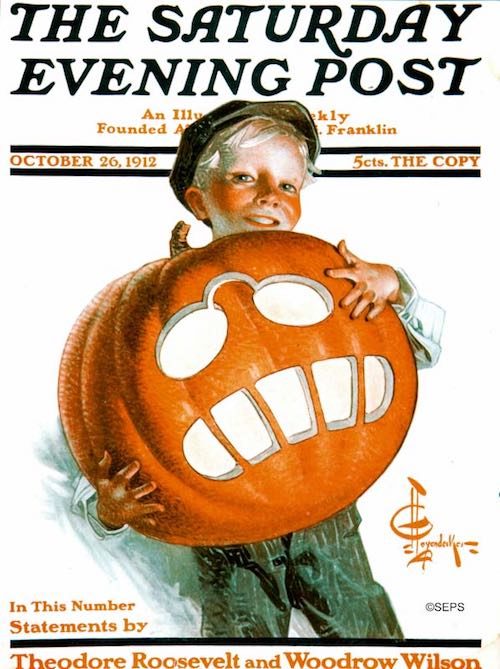
J.C. Leyendecker
October 26, 1912
This cover by J.C. Leyendecker depicts the face of Theodore Roosevelt, who ran for president against former friend William Howard Taft in 1912, even though Roosevelt had already held the office from 1901 to 1909. Neither won the election, and Roosevelt died seven years later.
If Roosevelt’s face isn’t immediately recognizable to you, I think David Letterman kinda works too.
Halloween Recipes
I’ve never understood the adult fascination with Halloween. I can understand kids getting excited by dressing up and getting five pounds of free candy, but I don’t get why October 31 is such a popular holiday with adults. I know people who spend more on Halloween than they do on Christmas. The night has changed a lot since I dressed up as Batman, and I think we should give it back to the kids.
But that doesn’t mean adults can’t enjoy the food of Halloween. How about this pumpkin-is-vomiting Guacamole Dip from Food Network’s The Kitchen? Or how about, from the same show, a Halloween Party Cake that looks like a graveyard, complete with headstones and dirt? Kids might like these Mummy Cookie Pops from Recipe Girl, and if you’re over 21 and fancy a cocktail, HGTV has a great list, including a Morgue-A-Rita and a Mr. Hyde Potion.
And if you find yourself at certain Taco Bell locations in Wisconsin (oh, if I had a dollar for every time I found myself at a Taco Bell in Wisconsin), you can try their new Chocoladilla, which is melted Kit Kat or Twix bars inside a grilled tortilla.
Next Week’s Holidays and Events
The David S. Pumpkins Halloween Special (October 28)
Last year, Saturday Night Live had a really goofy but undeniably funny sketch involving Tom Hanks as “David S. Pumpkins,” part of a “Haunted Elevator” Halloween ride. Now comes an all-new animated Halloween special, which airs Saturday at 11:30 p.m. on NBC, just before an SNL Halloween “best of” episode. Any questions?
Mischief Night (October 30)
We never knew about Mischief Night when I was a kid. If you wanted to decorate a home with toilet paper or a car with fresh eggs, you did it on Halloween night. You mean to tell me we could have done it two nights in a row?
Movember Begins (November 1)
“Movember” is the official name of the month devoted to men’s health. It’s also the month that the guys on Today, including Matt Lauer and Al Roker, stop shaving to support the effort and look like hoboes for 30 days.
Movies for the Rest of Us with Bill Newcott: God’s Not Dead
Award-winning film critic and writer Bill Newcott has been covering Hollywood for more than 40 years. He is the creator of AARP’s Movies For Grownups franchise and the movie critic for The Saturday Evening Post.
Cartoons: Technology Tomfoolery
These cartoons about the travails of technology are for anyone who’s fat-fingered a message, butt-dialed a friend, or been baffled by the latest gaming console.
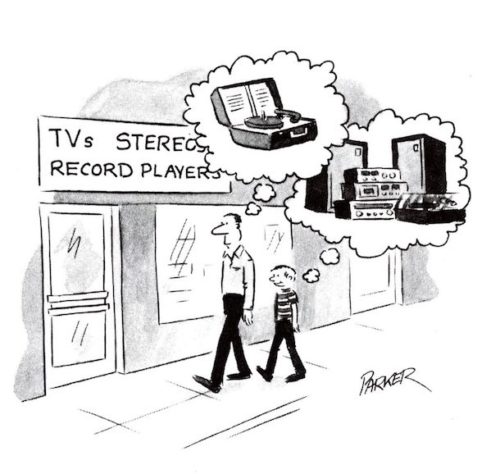
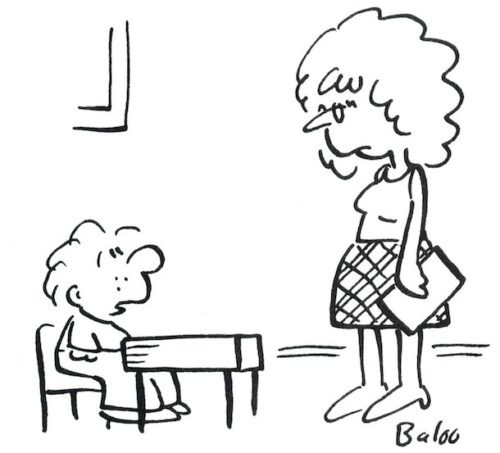
Baloo
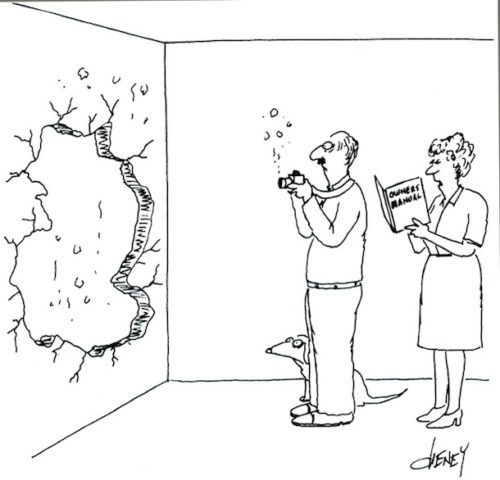
Tom Cheney
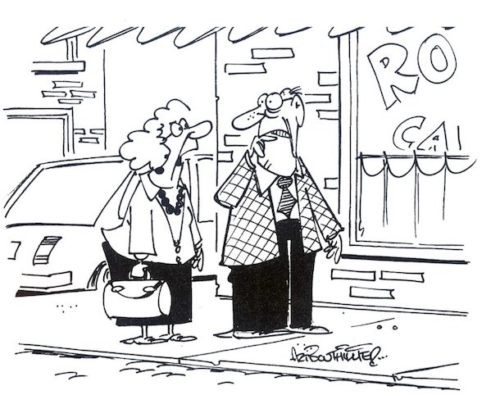
Art Bouthillier
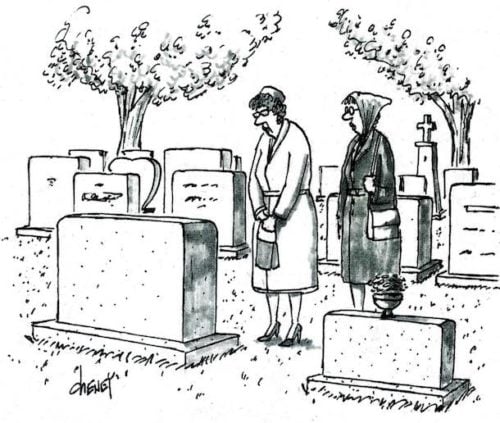
Tom Cheney
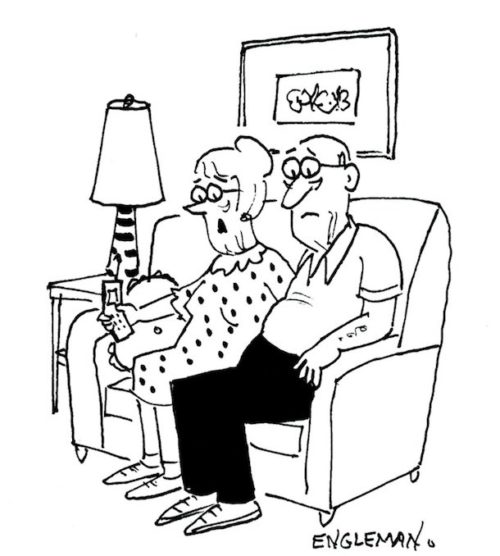
Earl Engleman
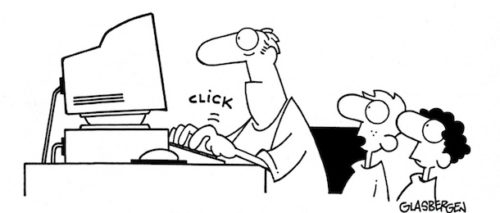
Randy Glasbergen
Rockwell Video Minute: Happy Halloween
Jack-o-Lanterns have made many appearances on the Post’s fall covers. It’s no surprise that Norman Rockwell’s earliest Halloween cover displays his own unique style.
See all of the videos in our Rockwell Video Minute series at www.saturdayeveningpost.com/rockwell-video.
How to Get a Good Night’s Sleep
The U.S. is in the middle of a “catastrophic sleep-loss epidemic,” according to Matthew Walker, director of the Centre for Human Sleep Science at the University of California, Berkeley. This lack of sleep affects all aspects of our health and may lead to obesity, mental health issues, and heart disease. Many place the blame on our modern way of life, with always-on devices, stressful jobs, and a wearying news cycle.
While sleeplessness may be on the rise, insomnia has plagued our nation from the start. Saturday Evening Post founder Ben Franklin was an acknowledged insomniac. He would wake up in the middle of the night and wile away a few hours reading in a chair (preferably naked).
In 1942, Americans’ sleep troubles were made worse by the country’s entry into World War II. In this light-hearted article from October 24 of that year, author Beatrice Schapper highlights the efforts of one man and his “Sleep Shop” to improve the slumber of stressed Americans. The devices could be comical — snore balls, bundling beds and smoking tubes are all featured — but the basic advice has never changed: find yourself a relaxing bed, a relaxing environment, relaxing devices, and a pleasant awakening.
If all else fails, the article leaves you with this cheery thought: “Don’t be afraid of insomnia. It won’t kill you not to sleep.”
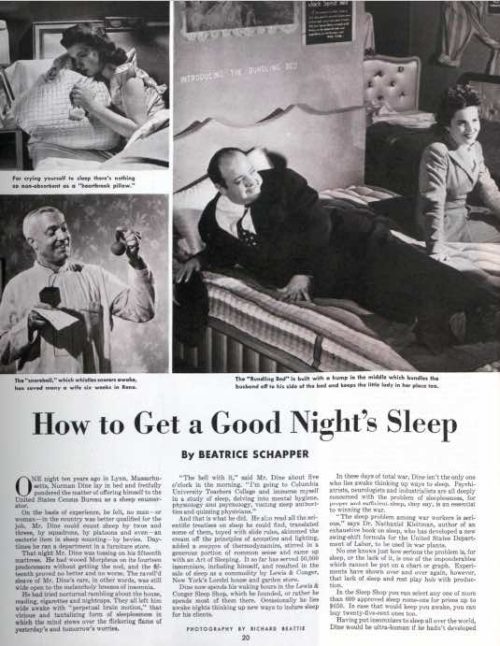
Top 10 Fall 2017 Reads
Every month, Amazon staffers sift through hundreds of new books searching for gems. Here’s what they chose especially for Post readers this summer.
Fiction
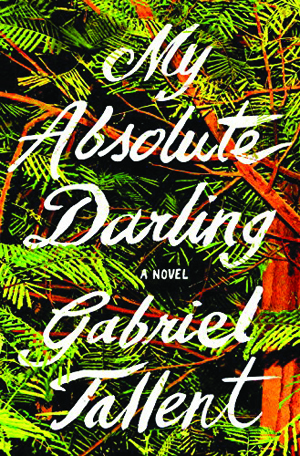
My Absolute Darling
by Gabriel Tallent
No debut is getting more praise this year than Tallent’s novel about a 14-year-old girl growing up in Northern California under the thumb of an abusive father.
Riverhead Books
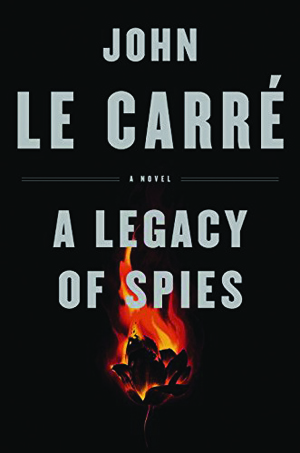
A Legacy of Spies
John le Carré
With his first Smiley novel in more than 25 years, the master of the spy novel returns with a story that pits Cold War-era espionage against modern sensibilities.
Viking

Sing, Unburied, Sing
by Jesmyn Ward
The National Book Award-winning author tells the lyrical tale of a poor, troubled family striking out from rural Mississippi on an epic odyssey fraught with hope and danger.
Scribner
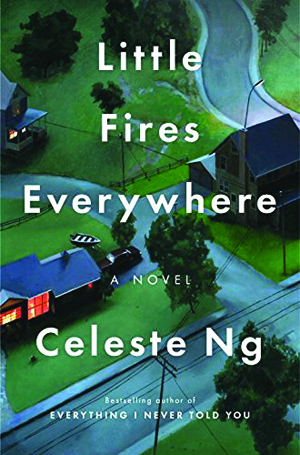
Little Fires Everywhere
by Celeste Ng
In the second novel by the author of Everything I Never Told You, an enigmatic artist’s secret past threatens to upend a carefully ordered suburban community.
Penguin Press
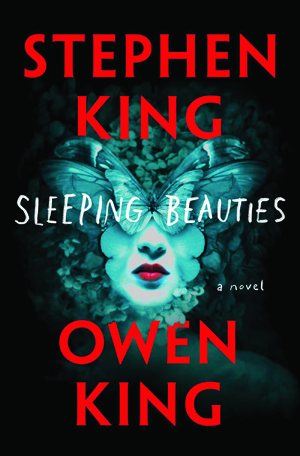
Sleeping Beauties
by Stephen King and Owen King
What if all of the women in the world went to sleep save one? Stephen King and son take a deep, dark look at what would happen to men.
Scribner
Nonfiction

The Vietnam War
by Geoffrey C. Ward and Ken Burns
The companion volume to the major, multipart PBS documentary to be aired in September explores the war from every side.
Knopf
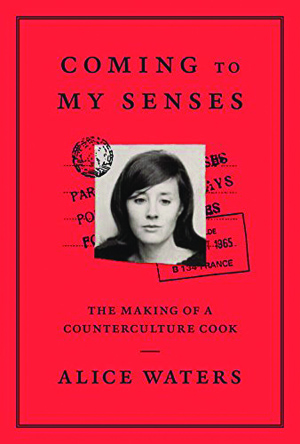
Coming to My Senses
by Alice Waters
This is the long-awaited memoir by the culinary icon and founder in 1971 of Chez Panisse, the “little French restaurant” in Berkeley, California.
Clarkson Potter
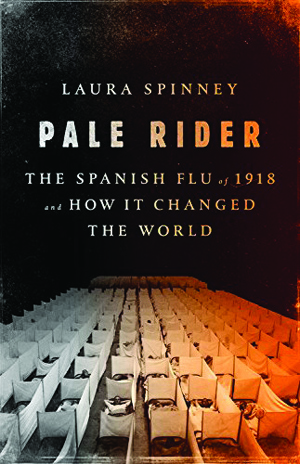
Pale Rider
by Laura Spinney
Spinney traces the devastating Spanish flu pandemic of 1918, which took upward of 100 million lives during the Great War.
PublicAffairs
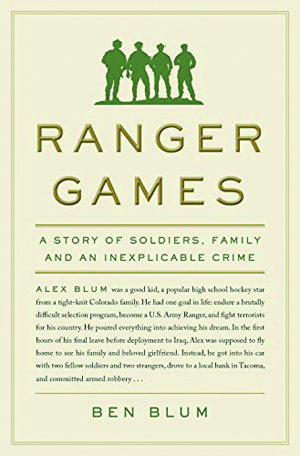
Ranger Games
by Ben Blum
This account of a young Army Ranger’s inexplicable crime and its implications for the Ranger program could be one of the surprise hits of the season.
Doubleday

Queens of the Conquest
by Alison Weir
Bestseller Weir examines five medieval English queens, stripping away myth and romanticism to present a clear-eyed look at their places in history.
Ballantine
Why Steinbeck Almost Didn’t Win the Nobel Prize
After the release of The Winter of Our Discontent in 1961, it occurred to the Swedish Academy that — after a drought of important fiction — perhaps John Steinbeck might still have a glorious summer ahead of him as a major candidate for the Nobel Prize in Literature. Steinbeck was announced as the Nobel laureate in 1962 — on this day — after what was later discovered to be an unenviable contention: The Swedish Academy didn’t consider any of its literature candidates worthy of the prize.
This inside knowledge wasn’t available at the time, of course. The Academy keeps its records of candidates and discussion private for 50 years. In 2012, the documents from 1962 were made public, and they revealed that Steinbeck was actually chosen out of necessity for a winner rather than enthusiastic acclaim from the committee. The Swedish Academy announced, on October 25, 1962, that it was awarding the prize to Steinbeck “for his realistic and imaginative writings, combining as they do sympathetic humour and keen social perception.” But, according to Svenska Dagbladet, committee member Henry Olssen had written of the choices, “There aren’t any obvious candidates for the Nobel Prize, and the prize committee is in an unenviable situation.” British authors Lawrence Durrell and Robert Graves were among the other candidates.
Despite accusations that Steinbeck’s work amounts to “tenth-rate philosophizing,” his novels and essays are still read widely in American classrooms. Sprawling novels such as The Grapes of Wrath and East of Eden and shorter studies of humanity like Of Mice and Men occupy the American consciousness with authentic tropes of our past.
Though Steinbeck never wrote fiction for The Saturday Evening Post, his last published piece, a 1966 essay called “America and the Americans,” was a cultural indictment as well as a unique celebration of the American people that appeared in the pages of the Post. The editor’s foreword to the piece warned: “The Grapes of Wrath roused a storm of controversy because of its strongly proletarian sympathies,” but the essay that followed was less in Steinbeck’s leftist tradition than it was in his tradition of “keen social perception.”
Steinbeck’s essay reads, even in 2017, as an apt analysis of America’s issues with affluence, racial tensions, and a new search for meaning. “America and the Americans” delivers Steinbeck’s ability to dissect family and culture across generations to diagnose 20th — and maybe 21st — century problems. “Even in our so-called virtues we are intemperate,” he writes, “…We are able to believe that our Government is weak, stupid, overbearing, dishonest, and inefficient, and at the same time we are deeply convinced that it is the best Government in the world, and we would like to impose it upon everyone else.”
His critique of uniquely American attitudes and paradoxes seems to support the Academy’s reasons for awarding him the highest honor in literature, even if the Swedish committee was initially apprehensive at their choice.
Steinbeck delivered an acceptance speech for his award in 1962, giving his take on “the nature and direction of literature” and offering his signature view of humanity’s needs and threats. He died in 1968, two years after “America and the Americans.”
Ironically, after leaving the world with a scathing critique of consumerism and excess, his heirs continue to wage multimillion-dollar lawsuits against one another to profit from his estate. Of course, endless litigation is as American now as migrant farming was during the Great Depression. Steinbeck’s legacy was one of a historian as well as an admonisher, out to save us from ourselves: “Could it be that below the level of thought, our people sense the danger of the swarming, crowding invasion of America by Americans?”
Preview Our November/December 2017 Issue
Take a peek inside our November/December 2017 issue! We have a nail-biter about an American doctor’s run-in with the KGB, the amazing story of a pianist’s fading memory and the musician who helped bring his songs to life again, and a lesson on how to live on less to give more. Plus great art, fiction, and gems from our archive. Watch our issue preview video and then subscribe!
Cover Collection: The Striking Art of Guernsey Moore
Guernsey Moore (1874-1925) was instrumental in changing the look of The Saturday Evening Post in the early 1900s. In the 1800s, the Post looked like a standard tabloid newspaper; Moore and artist J.J. Gould redesigned it to be the illustration-heavy magazine that still exists today.
Moore was one of the most prolific artists for the Post, painting 62 covers over the course of his career. His work was immediately recognizable for its heavy black outlines, poster-style compositions, and somber models. Below is a selection of some of our favorite covers.
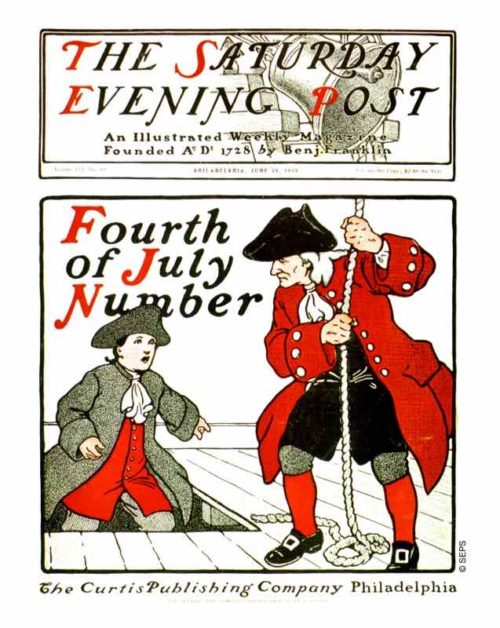
June 30, 1900
This cover from June 30, 1900, was the Post’s first Fourth of July cover, as well as Moore’s first cover for the magazine. Here we see patriots ringing the Liberty Bell. Using colonials as representatives of the Fourth was popular before the days of fireworks and parades. Note that Moore also illustrated the new lettering for the Post’s masthead.
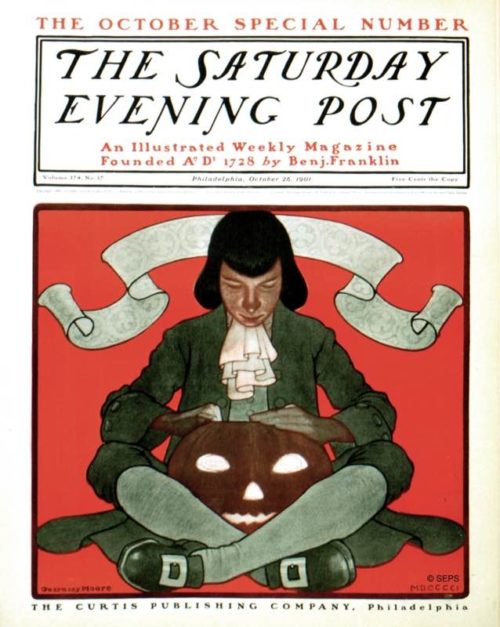
October 26, 1901
Moore’s Halloween cover shows that Jack-o-lanterns have been popular for quite some time. In fact, they date back to nineteenth century Ireland, where turnips were carved into grotesque faces in order to ward off evil spirits.
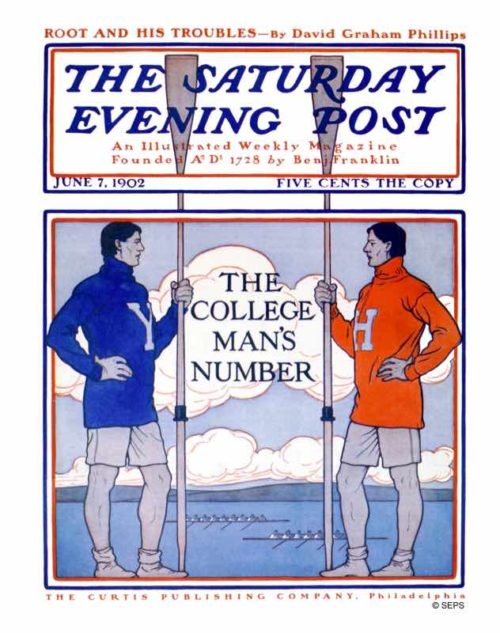
June 7, 1902
Throughout the nineteen-aughts, the Post featured at least one “College Man’s Number” a year, highlighting the benefits that these (mostly Ivy League) schools could impart to virile, dapper, and fun-loving young men. According to Daniel A. Clark in his book, Creating the College Man: American Mass Magazines and Middle-Class Manhood, “In no uncertain terms, the transformation of the college man was intertwined with a broad shift in masculine ideals that occurred in the late nineteenth and early twentieth centuries.” As one of America’s most popular magazines, the Post played a significant role in facilitating that shift.
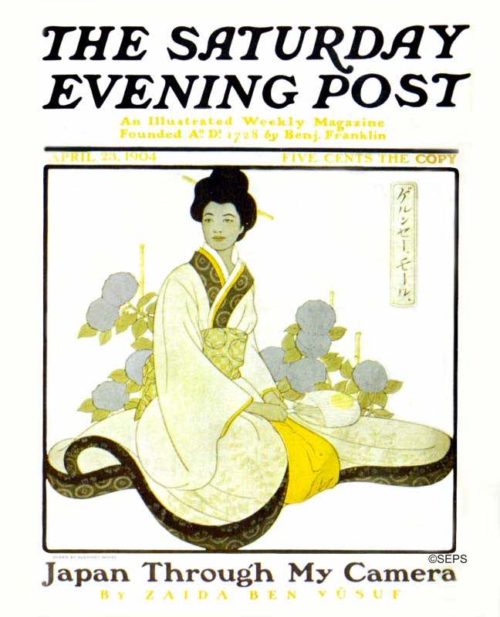
April 23, 1904
America’s interest in Asian culture grew in the 1920s, showing up in Western fashion, furniture, and textiles. This interest in the Far East was also reflected in many Saturday Evening Post covers of the era, including Moore’s depiction of a Japanese woman.
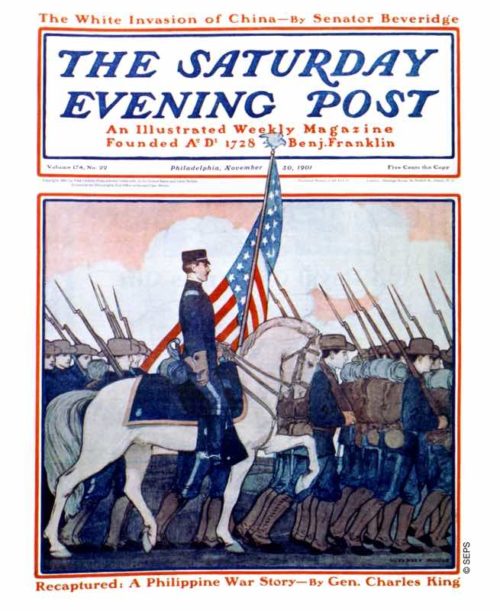
November 30, 1901
This illustration captures a scene from the little remembered Philippine-American War, 1899-1902. The conflict was sparked when the U.S. took possession of the Philippines from Spain at the conclusion of the Spanish-American War.
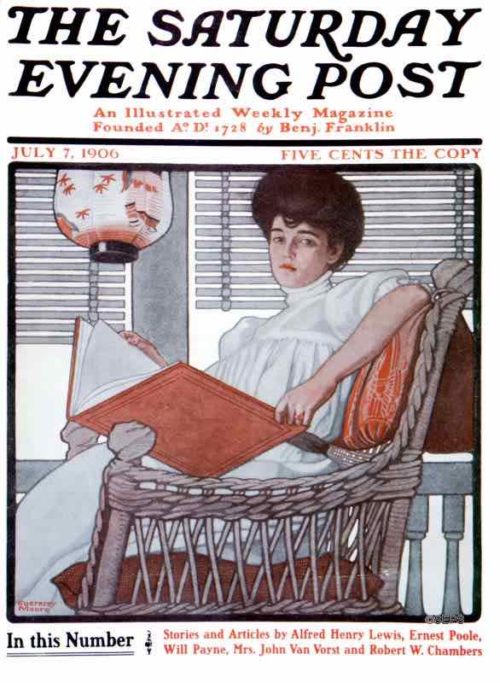
July 7, 1906
This seated woman is typical of the way Moore painted all of his models; in the midst of some enjoyable activity, but with a somber gaze. Whether they were gardening, baking, or receiving a valentine, they rarely looked happy about it. Note the Asian décor represented by the paper lantern.
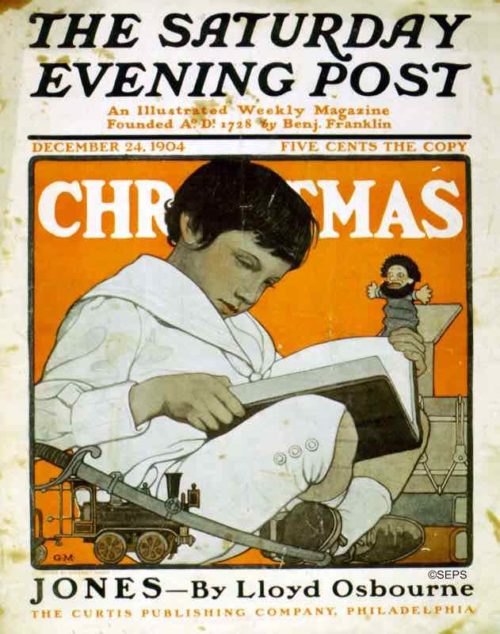
December 24, 1904
The Saturday Evening Post loved its Christmas covers, and Moore painted several. This was one of his few covers featuring a child. Despite being surrounded by many new toys, the boy’s subdued expression is quinetessential Moore.
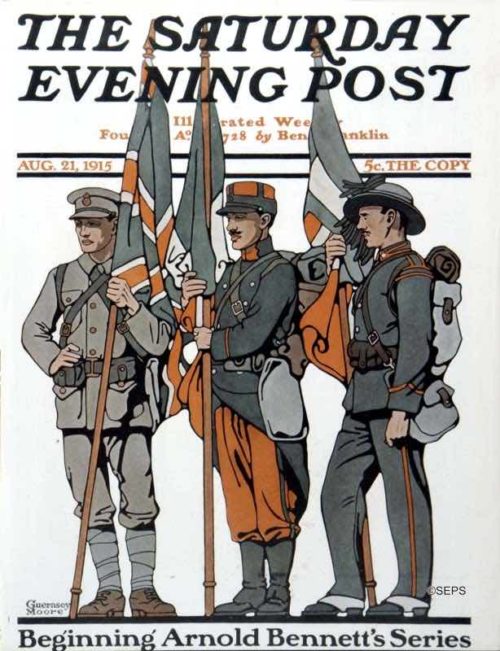
August 21, 1915
Moore depicted British, French, and Italian, soldiers, representing the three leading allied nations in Europe. Although the United States would not join World War I until 1917, the Great War was obviously on the minds of many Americans.
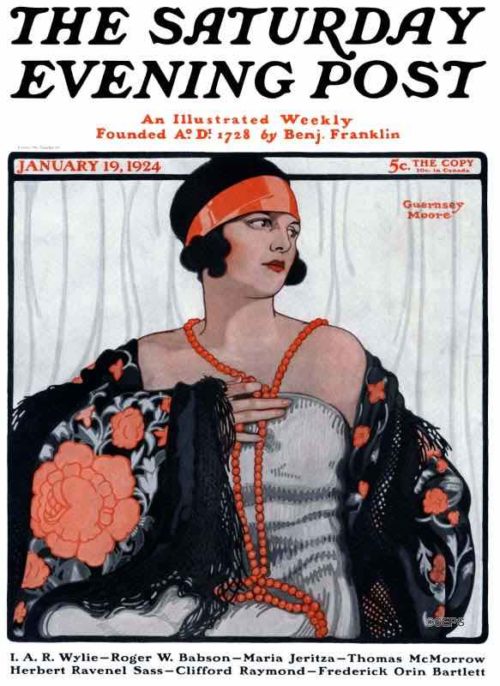
January 19, 1924
This is the last cover that Guernsey Moore painted for the Post. The cover is representative of his heavily outlined Arts and Crafts style. The large, brightly-colored flowers borrow motifs of the Far East.